Cyberbullying and internet addiction: relationship, definition, types, handling, and prevention
Table of content
- Why is internet addiction associated with cyberbullying (cyberharassment)?
- What is cyberbullying?
- What are the types of cyberbullying?
- What are the causes of online bullying?
- What are the symptoms of cyberharassment?
- What are the effects of online bullying?
- How do you handle cyberbullying?
- How do you prevent cyberbullying?
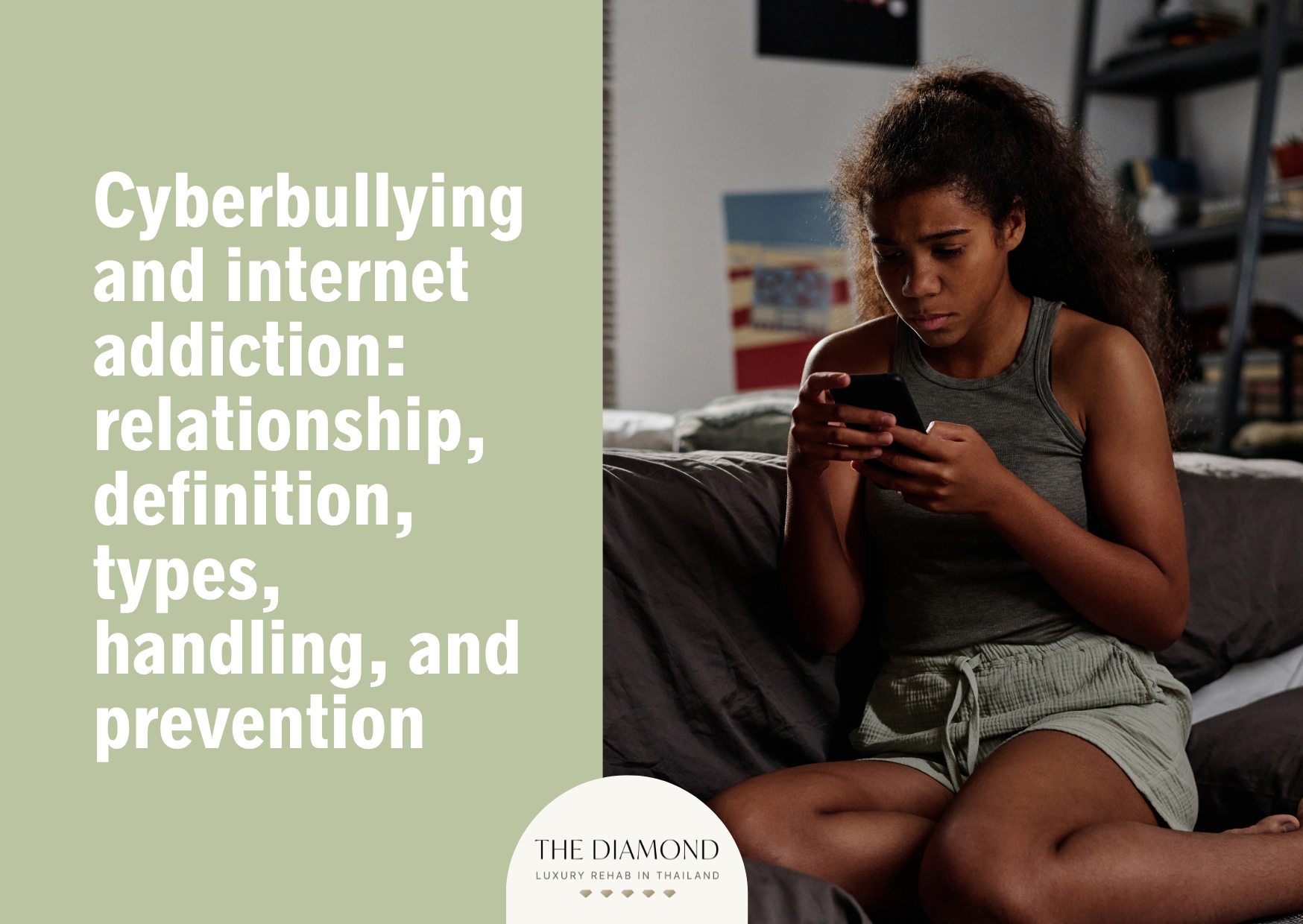
The relationship between cyberbullying and internet addiction entails a complicated interaction wherein excessive online engagement heightens vulnerability to harmful digital encounters. Individuals spending long hours online face a greater risk of either becoming targets or perpetrators of cyberbullying.
Internet addiction denotes the compulsive or uncontrolled utilization of the internet interfering with daily obligations. Excessive use of electronic media (such as social networking, gaming or web browsing) in the face of detrimental consequences is among the hallmarks of the condition.
Cyberbullying is when someone uses a digital platform to harass, threaten or degrade another individual. It frequently entails persistently damaging conduct through posts, texts or remarks meant to inflict emotional distress.
The types of cyberbullying include social exclusion, cyberstalking, doxing, harassment, catfishing, fraping, impersonation and trolling.
Handling cyberbullying involves staying calm, avoiding engagement with the bully and using platform tools to block and report abusive behavior. Seeking help from trusted adults and keeping records of harassment ensures the situation is addressed properly.
The prevention of cyberbullying involves promoting responsible online behavior, securing accounts with strong passwords and adjusting privacy settings to limit exposure. Encouraging respect in digital interactions, thinking before posting and fostering open discussions about online safety help reduce risks as well.
Why is internet addiction associated with cyberbullying (cyberharassment)?
Internet addiction is associated with cyberbullying because constant engagement with the internet increases the likelihood of harmful online interactions. Individuals who spend long hours online often engage in unfiltered spaces where detrimental behavior is more likely to occur.
Round-the-clock presence in virtual environments creates more opportunities to witness or participate in cyberharassment. People struggling with internet addiction grow desensitized to harmful content, increasing the likelihood of accepting or repeating toxic behavior.
What is internet addiction?
Internet addiction describes problematic and excessive online activity interfering with everyday life and wellbeing. A need to avoid stress, boredom or emotional discomfort is frequently the driving force behind the disorder’s compulsive use of the internet.
Such an unhealthy behavior manifests through difficulty limiting screen time and prioritizing digital interactions over real-world connections. Continued reliance on online activity to manage mood or escape challenges worsens the addiction and adds difficulty to breaking the cycle. Left unaddressed, internet addiction contributes to strained relationships, reduced productivity and mental health issues.
How does internet addiction influence cyberbullying?
Internet addiction influences cyberbullying by making people spend more time online and increasing their exposure to harmful situations. Especially in unmoderated or anonymous digital spaces, a sustained online presence increases the likelihood of negative interactions.
Individuals struggling with excessive internet use experience emotional issues such as frustration or isolation, sometimes leading to aggressive behavior during online exchanges. A person’s inability to control their emotions causes them to snap at others, exacerbating cyberbullying problems.
The detachment created by screens weakens empathy and leads to targeting or ridiculing peers without regard for the consequences. In certain cases, addicted users become both victims and perpetrators within the same spaces, trapped in a loop of hostility and overexposure.
What is cyberbullying?
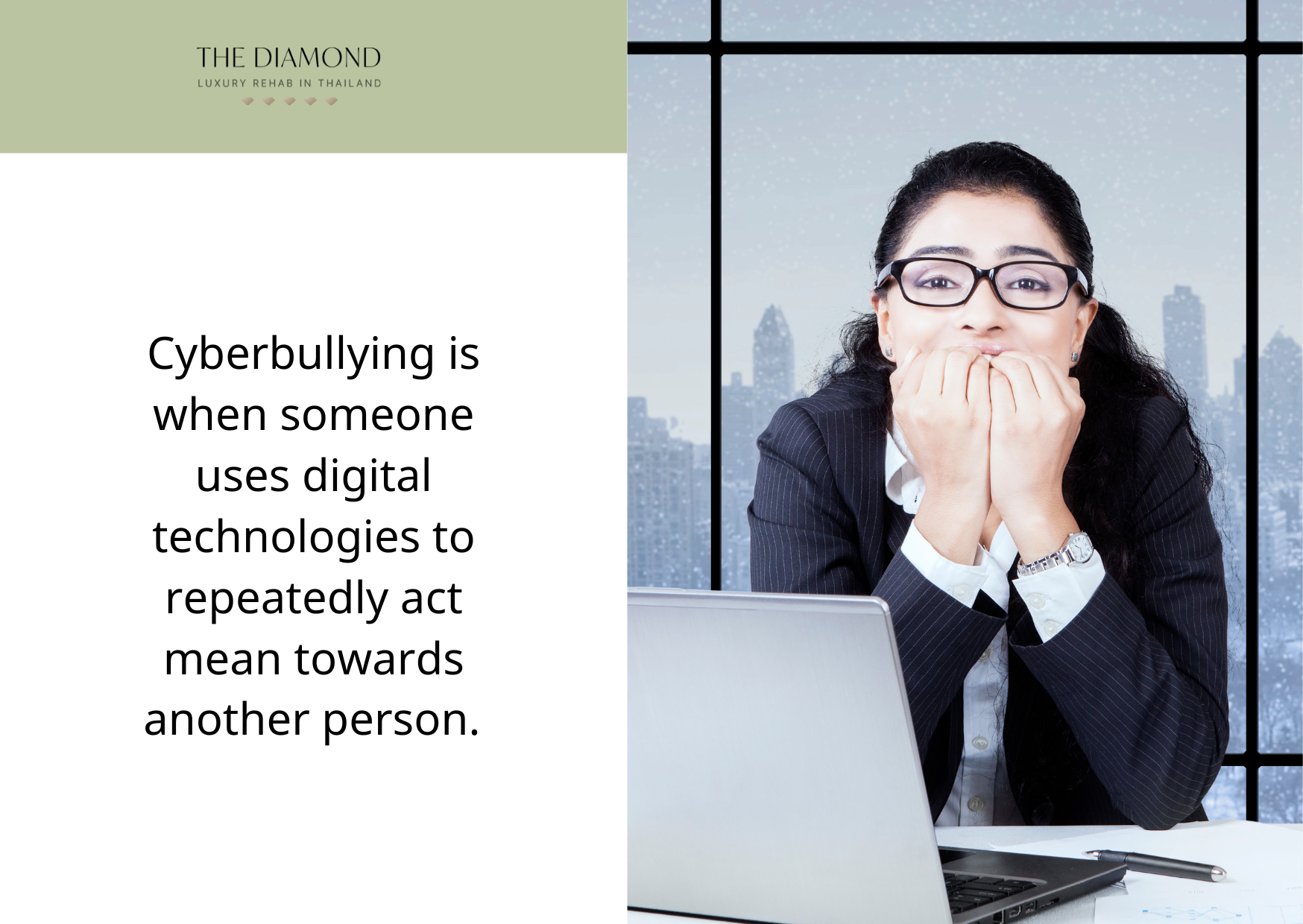
Cyberbullying is when someone uses digital technologies to repeatedly act mean towards another person. Using electronic platforms like social media, messaging apps or forums to bully people in destructive and persistent ways describes the behavior.
Individuals engaging in cyberbullying harass others through messages, posts or images designed to provoke or upset. Certain cyberbullies aim to embarrass victims publicly by sharing private or manipulated content.
Often, a person becomes the focus of ongoing online attacks, creating a sense of being trapped. Unlike traditional bullying, cyberbullying tends to occur at any time due to continual access to electronic devices, intensifying the emotional impact.
Why does cyberharassment happen?
Cyberharassment happens for a range of reasons rooted in personal insecurities or a desire to dominate others online. Individuals act out of envy, targeting people perceived as more successful, attractive or popular.
The digital space offers a shield, reducing accountability and encouraging behavior perceived as less risky behind a screen. Aggressors engage in unwanted or unprovoked actions simply to provoke reactions or gain attention. Power dynamics play a role, as cyberharassers use online platforms to belittle others in order to feel superior.
Unconsented conduct, such as tagging people in offensive posts or sharing private messages, adds to the harm. What starts as a joke or insult evolves into a serious threat to someone’s emotional safety.
Online habitual activities, loneliness and impulsivity are persistent risk factors for cyberharassment victimization across various cultural contexts, according to a 2022 article by Mikkola et al., titled “Cyberharassment Victimization on Three Continents: An Integrative Approach.”
Cyberstalking, a more persistent form of online harassment, includes repeated monitoring, messaging, or intimidation, blurring the line between bullying and criminal behavior. The goal shifts from a single act to a pattern of surveillance and fear, deepening the psychological toll. Together, the two actions reflect a disregard for personal boundaries and a need for control or dominance in virtual spaces.
How does cyberbullying happen?
Cyberbullying happens through various digital channels disguised as ordinary interactions. Offenders are likely to use SMS to send hurtful messages or spread lies intended to damage someone’s reputation. Text exchanges quickly turn hostile, especially when name calling becomes frequent.
Other individuals misuse personal photos by editing or sharing without consent, aiming to shame the person. Spreading rumors is now easier and more damaging than ever before because of social media apps allowing users to easily reach huge audiences.
Messages come from random accounts, allowing the bully to stay anonymous and avoid consequences. Group chats sometimes turn into spaces where one person becomes the target of jokes or coordinated harassment.
Bullying escalates from teasing to actions focused on undermining confidence or isolating the victim. When repeated or viewed by others, even a fleeting remark has far-reaching consequences.
How common is cyberbullying?
Cyberbullying prevalence varies widely; victimization rates vary from 13.99% to 57.5% worldwide, based on national studies with reports ranging from 14.6% to 52.2%, according to a 2201 study by Zhu et al., titled “Cyberbullying Among Adolescents and Children: A Comprehensive Review of the Global Situation, Risk Factors, and Preventive Measures.”
Malaysia recorded the highest rate (52.2%), followed by the United States and South Korea. National studies report perpetration rates ranging from 6.3% to 32%, with a range of 6.0% to 46.3%. Once more, Malaysia had the greatest rate of perpetration (31.8%), while Spain had the lowest (3.2–6.4%).
The figures show significant global variation, with verbal violence being the most prevalent cyberbullying behavior.
What are the types of cyberbullying?
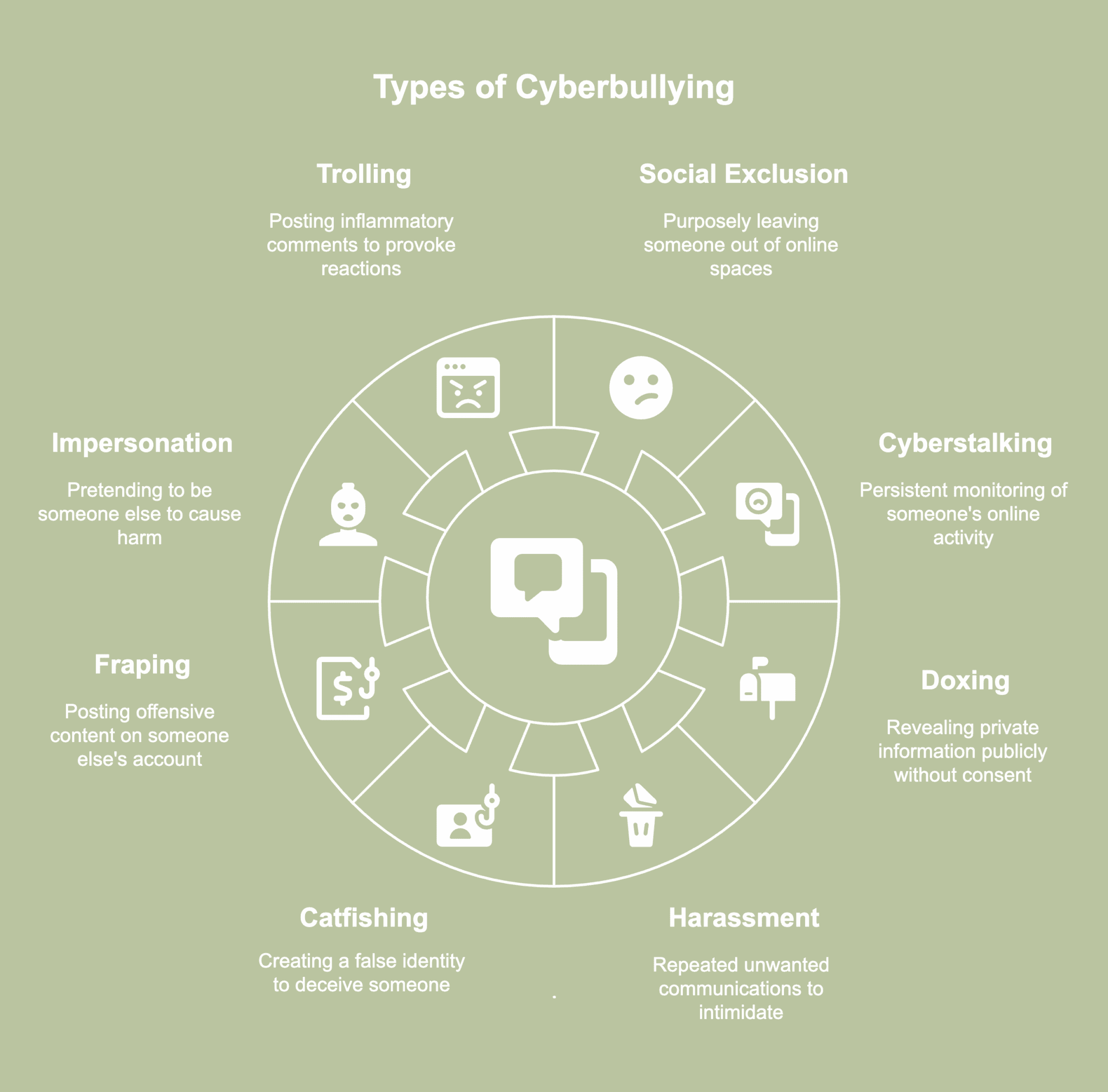
Types of cyberbullying describe the various negative online conduct occurring when someone uses technology to threaten, degrade or hurt another person. The types of cyberbullying are listed below.
- Social exclusion: Social exclusion happens when a person is purposely left out of online spaces or conversations. Removal from group chats or silence in community threads send a clear message of rejection. The behavior damages confidence and fosters feelings of isolation. Victims sometimes withdraw from digital and real-world interactions altogether.
- Cyberstalking: Cyberstalking involves persistent monitoring of another person’s online movements without consent. The behavior usually escalates into unwanted contact, leaving the target anxious and unsettled. The ongoing intrusion causes the victim to feel watched during every online session. Numerous individuals limit or stop using certain platforms to avoid the harasser.
- Doxing: Doxing is the release of private details—such as addresses or phone numbers—into public view without permission. Once information spreads, removing the content becomes nearly impossible. Victims face both emotional distress and safety concerns. Doxing affects 12% of adolescents, increasing disclosure risks and varying by gender/intentions, as noted in a 2019 article by Chen et al., titled “Doxing: What Adolescents Look for and Their Intentions.” Girls showed a higher tendency to engage in social doxing intended to gather social information, while boys more often participated in hostile doxing aimed at acquiring personally identifiable data and information about others’ living arrangements.
- Harassment: Harassment occurs when someone delivers repeated, unwanted communications meant to intimidate or degrade. The form of conduct includes direct messages attacking character or public posts intended to humiliate. Prolonged exposure to such hostility leads to heightened stress. In extreme cases, the abuse harms both mental health and daily functioning.
- Catfishing: Catfishing happens when a person uses a false identity to deceive someone online. The deception is aimed at building fake relationships, committing fraud or gaining private details. Discovering the truth results in embarrassment and loss of trust. Emotional harm tends to linger long after the interaction ends.
- Fraping: Fraping takes place when an individual gains access to another person’s account without consent and posts in their name. Combining the words “Facebook” and “rape,” the term reflects how the idea initially gained widespread recognition due to instances on the social media site. The content is typically offensive, damaging or humiliating, and victims are publicly laughed at for things they never said.
- Impersonation: Impersonation involves pretending to be someone else online to cause harm or spread misleading content. False identities are frequently used to get in contact with friends, spread damaging gossip or change how the victim is perceived by the general public. Impersonation ruins trust and reputations in social circles.
- Trolling: Trolling is the act of posting inflammatory comments or disruptive content to provoke emotional reactions. While certain people frame trolling as playful teasing, the targeted individual experiences real emotional harm. Findings of a 2023 paper by Soares et al., titled “To troll or not to troll: Young adults’ anti-social behaviour on social media” suggested anti-social behavior originates from perceiving social media as an “entertainment frame,” wherein damaging actions yield enjoyment or social standing. Reduced cognitive empathy indicated offenders underestimate the extent of harm, hence prolonging cycles of abuse.
What are the causes of online bullying?
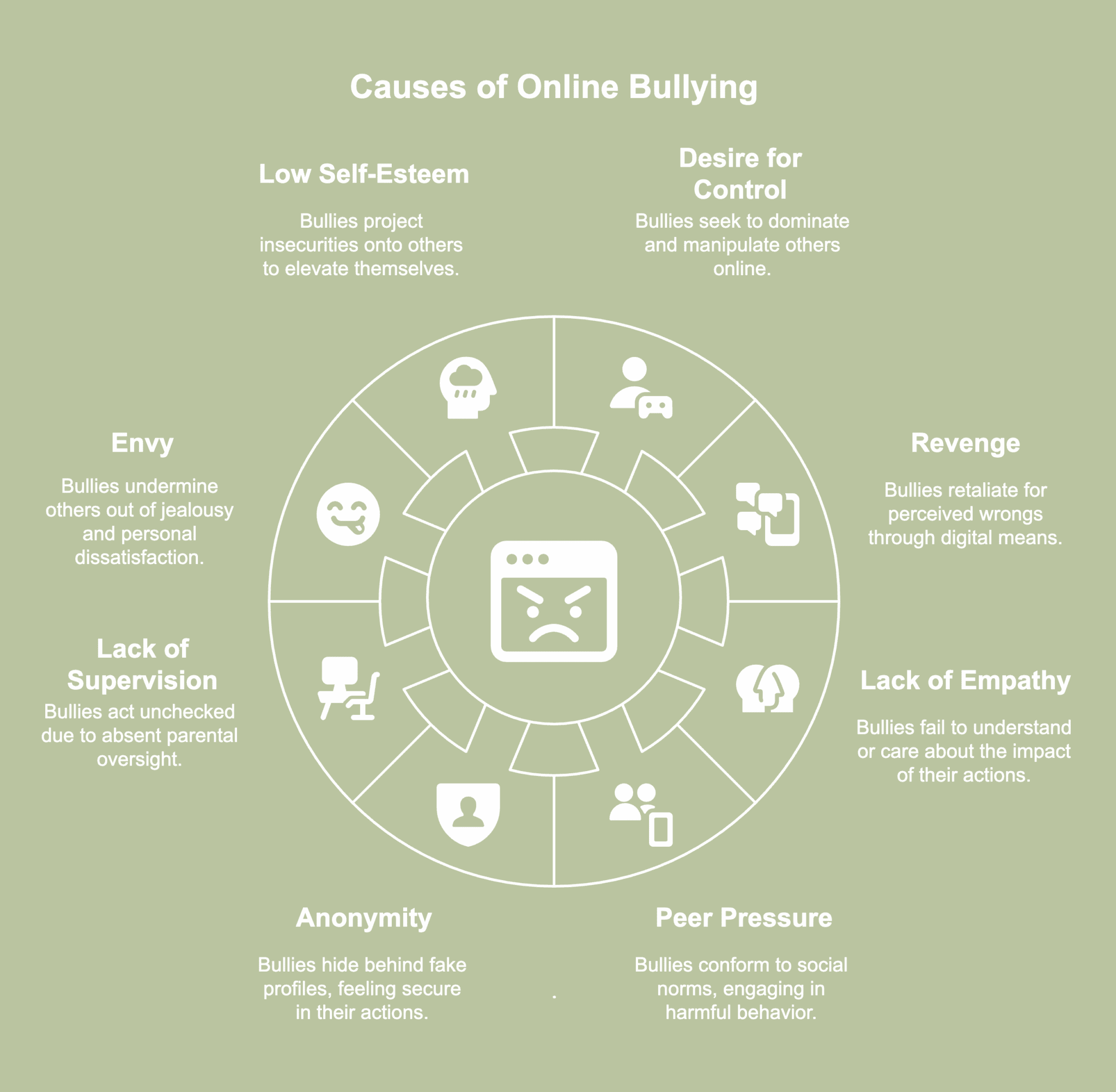
Causes of online bullying pertain to the fundamental elements motivating individuals to carry out harmful digital conduct against others. The causes of online bullying are listed below.
- Desire for control: Certain individuals bully online to dominate or manipulate others. Tactics like threats and spreading false information are used to maintain a sense of authority. A desire for control stems from feeling powerless in other areas of life. Online platforms become a tool to exert influence without direct confrontation.
- Revenge: Online bullying sometimes happens as retaliation for perceived wrongs. The bully may feel justified, believing the other person deserves the treatment. Digital tools enable the rapid spread of rumors or harmful content. Such actions escalate conflicts rather than resolve disputes.
- Lack of empathy: Many individuals fail to understand or care about how their actions affect others. Without emotional connection, aggressors view targets as objects rather than people. Such detachment makes harmful comments and actions feel less wrong in the aggressor’s mind. Teaching empathy remains one of the most effective ways to counter that mindset.
- Peer pressure: Influence from friends or social groups drives harmful online conduct. The need for acceptance prompts actions going against personal morals. Social influence makes online cruelty seem acceptable within one’s own circle. According to a June 2025 paper by Espino et al., titled “Adolescents Suffering from Long-term Cyberbullying Victimisation: Peer Pressure and Anger Dysregulation as Risk Factors,” peer pressure increases the risk of long-term cybervictimization, and is moderated by anger dysregulation. The impact is most pronounced at moderate/low levels, underscoring the interplay between emotional control and conformity requirements in the perpetuation of harm.
- Anonymity: The ability to hide behind a screen name or fake profile removes the immediate consequences of harmful actions. Without direct face-to-face interaction, bullies feel more comfortable behaving aggressively. The hidden identity creates a false sense of security, encouraging them to act in ways often avoided offline. As a result, anonymity fuels bolder and more harmful conduct online.
- Lack of supervision: When parents or guardians do not monitor online activity, harmful behavior goes unchecked. The absence of oversight allows bullies to continue without facing immediate repercussions. Over time, the situation creates an environment where targeting others becomes routine. Effective supervision reduces incidents by setting boundaries and holding individuals accountable.
- Envy: Feelings of jealousy toward someone’s achievements, appearance or relationships tend to spark online bullying. Instead of addressing personal dissatisfaction, bullies try to undermine the target. The behavior involves hurtful comments, mockery or attempts to damage reputations.
- Low self-esteem: Insecure individuals sometimes project personal dissatisfaction onto others. Digital attacks serve as a means to elevate personal status. Hurting another person creates a false sense of power and eventually masks deeper emotional struggles.
What are the symptoms of cyberharassment?
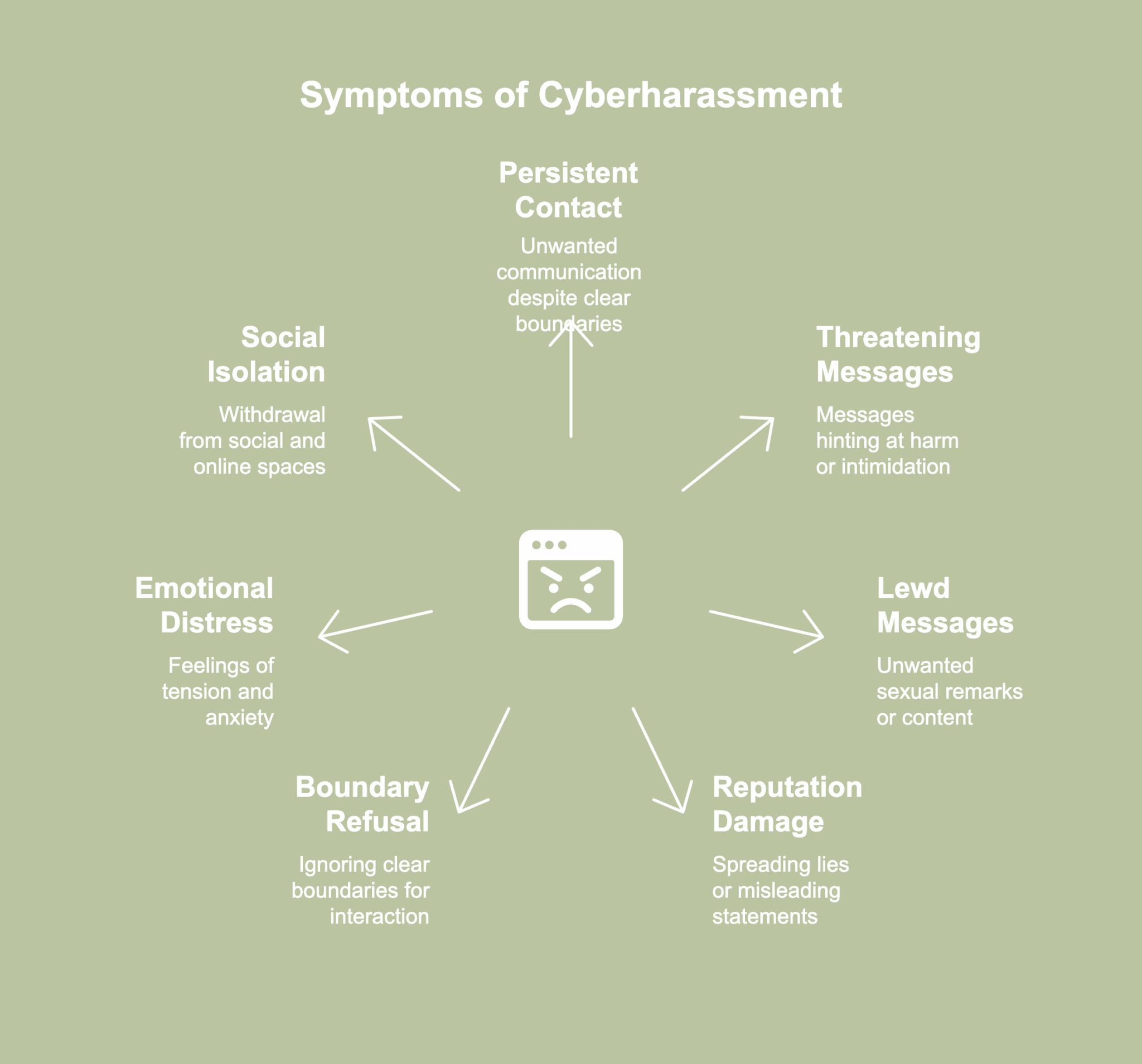
Symptoms of cyberharassment are the behavioral, psychological and emotional indicators a person is being harassed or abused online on a regular basis. The symptoms of cyberharassment are listed below.
- Persistent unwanted contact: Victims experience a continuous stream of unwanted communication even after firmly expressing a desire for no further interaction. Messages feel intrusive and create an atmosphere of pressure or intimidation. The repeated intrusion disrupts a sense of personal safety and privacy. The behavior typically escalates into cyberstalking, where the harasser monitors the target’s online presence and activities.
- Threatening or intimidating messages: Cyberharassment involves sending messages hinting at or directly promising harm. The threats relate to personal safety, reputation or emotional well-being. Even when not acted upon, statements from the perpetrator instill fear and unease.
- Sexually lewd messages: Unwanted sexual remarks or explicit content is a common tactic used to make someone feel uncomfortable. Such content arrives unexpectedly and makes digital spaces feel unsafe. The discomfort from sexualized remarks leads to reduced online participation. The conduct creates a lingering fear of interaction, even in previously safe environments.
- Attempts to damage reputation: Harassers spread lies, altered images or misleading statements to tarnish a victim’s credibility. Public shaming occurs through social media posts, forums or direct messaging. False information spreads rapidly, leaving the victim with limited ability to control the narrative. Victims of public humiliation (e.g., being ridiculed online for personal characteristics or actions) were more likely to engage in similar behaviors, thereby perpetuating a cycle of retaliation, according to a 2022 study by Zhan et al., titled “The relationship between cyberbullying victimization and cyberbullying perpetration: The role of social responsibility.”
- Refusal to respect boundaries: A common sign of cyberharassment is when an individual continues to push for interaction after clear boundaries have been set. Instead of stepping back, the harasser finds new ways to make contact or draw attention. Persistence erodes the victim’s confidence in maintaining personal control over digital interactions.
- Emotional distress: Ongoing harassment leaves a person feeling tense, restless and constantly alert to potential harm. Even neutral messages trigger an anxious reaction, as the mind becomes conditioned to expect hostility. Physical symptoms like rapid heartbeat or nausea tend to accompany emotional strain. Prolonged exposure to stress affects overall well-being and quality of life.
- Isolation from social and online spaces: In an effort to escape further harassment, victims withdraw from social media, online forums and even real-world gatherings. This self-protective step results in loneliness and the loss of supportive connections. Although the approach reduces immediate exposure to the harasser, the disruption frequently extends to work, hobbies and personal relationships.
What are the effects of online bullying?
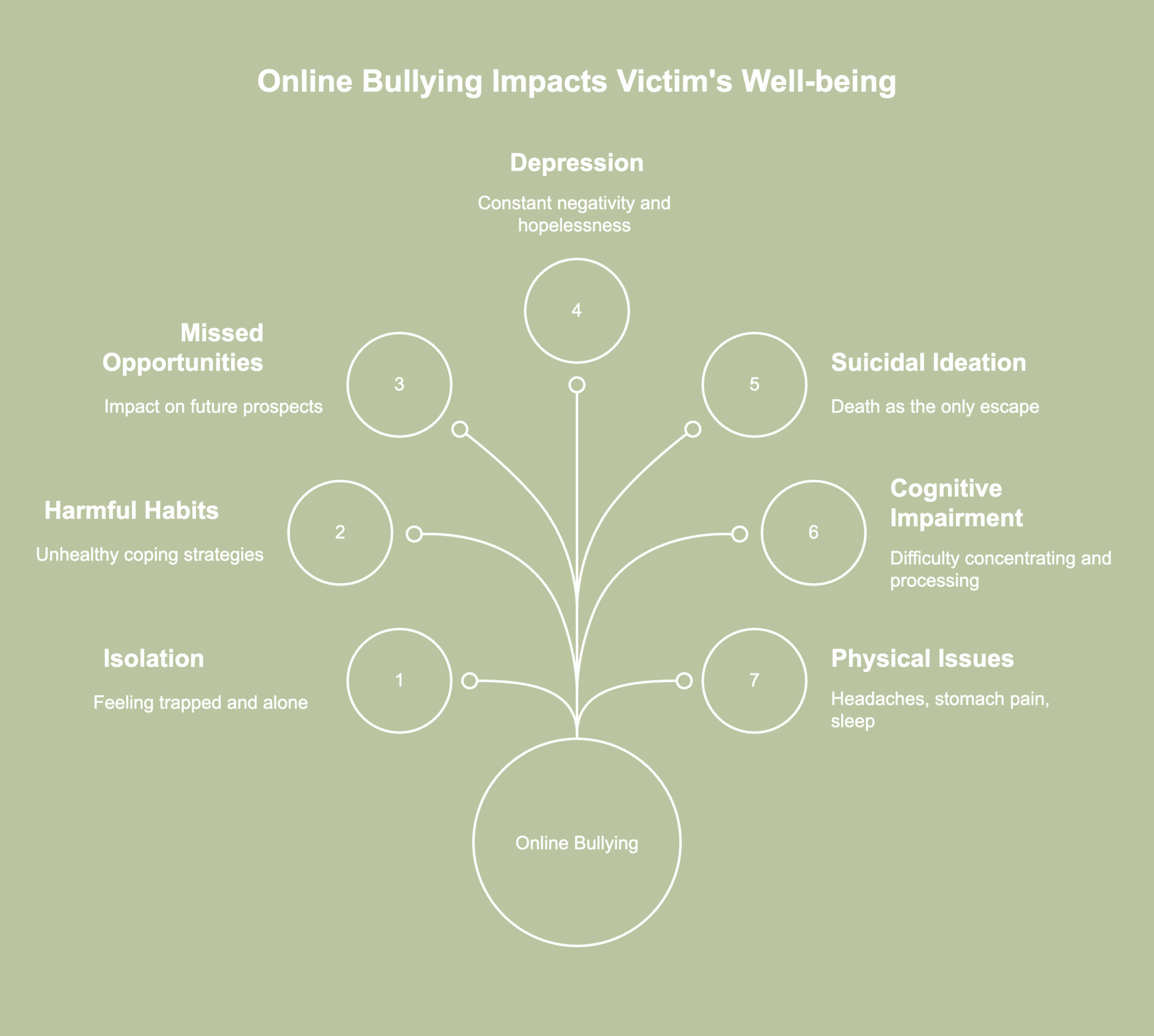
Effects of online bullying describe the outcomes victimized individuals face as a result of cyberattacks. The effects of online bullying are listed below.
- Feeling trapped and alone: Targets of online bullying feel surrounded by hostility with no safe outlet for relief. The digital environment allows harassment to follow individuals into personal spaces, removing any sense of escape. Constant exposure to harmful messages fosters isolation, especially when friends or family fail to understand the severity of the problem.
- Harmful habits: Relentless online attacks sometimes push individuals toward unhealthy coping strategies. Increased reliance on alcohol, drugs or compulsive behaviors develops as an attempt to dull emotional pain. Harmful actions gradually disrupt routines, harm health and create new problems compounding the original distress. Recovery from both the harassment and the resulting harmful habits becomes increasingly difficult without intervention.
- College admissions and employment impact: Digital harassment leaves a permanent online footprint. Negative or false information posted about an individual influences decisions made by universities or hiring managers. Even when untrue, damaging content shapes perceptions before the person has a chance to present personal achievements. In various cases, opportunities vanish silently, leaving the victim unaware of the reason.
- Depression: Prolonged exposure to online bullying wears down emotional resilience. The constant negativity fosters feelings of worthlessness and hopelessness, overshadowing positive aspects of life. As per a 2022 study by Maurya et al., titled “The effects of cyberbullying victimization on depression and suicidal ideation among adolescents and young adults: a three year cohort study from India,” adolescents who encountered cyberbullying victimization were 2.07 times more likely to exhibit depressive symptoms in young adulthood than their non-victimized counterparts. This arises from the visibility, persistence and invasiveness of online harassment.
- Suicidal ideation: In severe cases, victims of online bullying begin to view death as the only way to stop the pain. Persistent harassment strips away hope and creates the belief escape is impossible through any other means. Thoughts about self-harm or ending one’s life surface more frequently as the distress intensifies. Without urgent intervention from trusted individuals or professionals, the situation escalates to tragedy.
- Difficulty concentrating and processing information: Sustained emotional distress from online bullying interferes with mental clarity and focus. Tasks requiring attention become harder to complete, and retaining new information feels overwhelming. Findings of an April 2025 study by Solas-Martínez et al., titled “Bullying and cyberbullying is associated with low levels of cognitive and metacognitive learning strategies in young people” revealed that across all five learning strategies—elaboration, rehearsal, critical thinking, organization and metacognitive self-regulation—students who were either victims or aggressors of bullying or cyberbullying demonstrated lower scores. This hints at how exposure to hostility disrupts mental processes critical for the retention, acquisition and self-directed learning of knowledge.
- Physical health issues: Stress from online bullying manifests in physical symptoms such as headaches, stomach pain or sleep disturbances. Prolonged tension impacts the immune system, making illnesses more frequent or harder to overcome. Fatigue and chronic discomfort further reduce quality of life. Health problems add another layer of difficulty to an already challenging situation.
How does cyberbullying impact mental health?
Cyberbullying impacts mental health by undermining victims’ feeling of security as a result of the severe emotional stress the situation causes. Anxiety, depression and feelings of inadequacy constitute a few of the mental health issues victims are more prone to experiencing.
Prolonged exposure to harassment frequently causes depressive symptoms, making day-to-day tasks feel overwhelming and uncontrollable. The inability to truly engage in personal relationships, work or school is a common consequence of constant stress, affecting both concentration and decision-making.
Numerous individuals encounter sleep disturbances, including challenges in initiating sleep and recurrent nightmares, further diminishing emotional resilience. Fear of being mocked or attacked online sometimes leads students to skip school, stunting both social and academic growth.
Continued isolation from peers and support networks increases vulnerability to further psychological harm. Self-esteem eventually erodes and trust in others diminishes, intensifying the emotional toll. Without proper intervention, cyberbullying’s impact is likely to escalate into lasting mental illness requiring professional support.
Why is cyberbullying dangerous?

Cyberbullying is dangerous because it often reaches victims anywhere and at any time, leaving little opportunity for escape or recovery. The constant accessibility of digital platforms allows harmful messages, images or rumors to spread quickly and widely.
Constant exposure raises the risk of mental health conditions like depression and anxiety. Victims frequently experience social withdrawal, low self-esteem and loss of interest in daily activities.
The emotional burden leads to intense shame and creates greater difficulty in seeking help or speaking openly about the abuse. Compared to in-person bullying, online harassment sometimes involves anonymity that emboldens aggressors to act with greater persistence and cruelty.
The public nature of social media further magnifies the humiliation, as harmful content is shared with large audiences in seconds. Being constantly subjected to such kind of abuse results in self-harm or suicidal thoughts. Inflicting harm on a person’s mental health, social life and emotional well-being, cyberbullying is far from harmless.
How does social media affect cyberbullying?
Social media affects cyberbullying by providing attackers with a larger audience and quicker means of disseminating damaging content. Through eliminating the barrier of physical distance, bullies are able to target victims on platforms outside of traditional school or workplace settings.
The ability to remain anonymous or use fake accounts encourages more aggressive behavior because accountability feels limited. Harmful posts or messages are shared and reshared, keeping the abuse visible for extended periods.
Moreover, algorithms pushing popular content unintentionally help keep cruel material circulating. The pressure of constant scrolling linked to social media addiction leaves victims feeling trapped, unable to disconnect from platforms that fuel comparison and harassment.
Harassment occasionally crosses over to other applications or websites, posing difficulties for victims attempting to disengage. The interconnected structure of social media ensures once cyberbullying begins, the abuse is likely to escalate rapidly and persist across several online spaces.
How do you handle cyberbullying?
In order to handle cyberbullying, a calm and strategic approach is vital to protect emotional well-being and personal safety. The first step is to ignore hurtful messages or posts, as engaging with the bully is likely to encourage further harassment.
Seek advice from trusted individuals able to provide guidance on the best course of action. Parents must be informed immediately, especially if the bullying affects mental health or daily life. Talk to a school counsellor, teacher or another responsible adult to ensure the problem is addressed in the right setting.
Use platform tools to block the bully, preventing them from sending messages or viewing your profile. Do not respond to any abusive content, since such behavior tends to escalate the situation. Avoid forwarding harmful messages, as sharing them can possibly spread the damage and intensify the harm.
Keep screenshots or records of the harassment in case a report needs to be filed. Finally, take action by reporting the bully to the platform administrators or relevant authorities so appropriate steps are taken to stop the abuse.
How do you prevent cyberbullying?
To prevent cyberbullying, educate yourself and others on how to act responsibly when using the internet and the repercussions of damaging behaviors. For protection against unwanted access to accounts, create strong, unique password combinations.
Adjust privacy settings to control who views your posts, photos and personal details. Always log out of shared devices to prevent others from misusing your accounts. Strive to be a good digital citizen by showing respect and kindness in all online interactions.
Think or pause before posting online, as taking a moment to reflect prevents sharing content capable of harming others or damaging reputations. Familiarize yourself with platform policies to understand how cyberbullying is handled and reported. Create an environment at home, school or work where open discussions about online safety feel natural and encouraged.
Lastly, report any harmful behavior promptly and encourage others to do the same to help protect the community. Leading with positive habits not just safeguards you but contributes to building a more respectful online world.
Is raising awareness about cyberbullying effective in prevention?
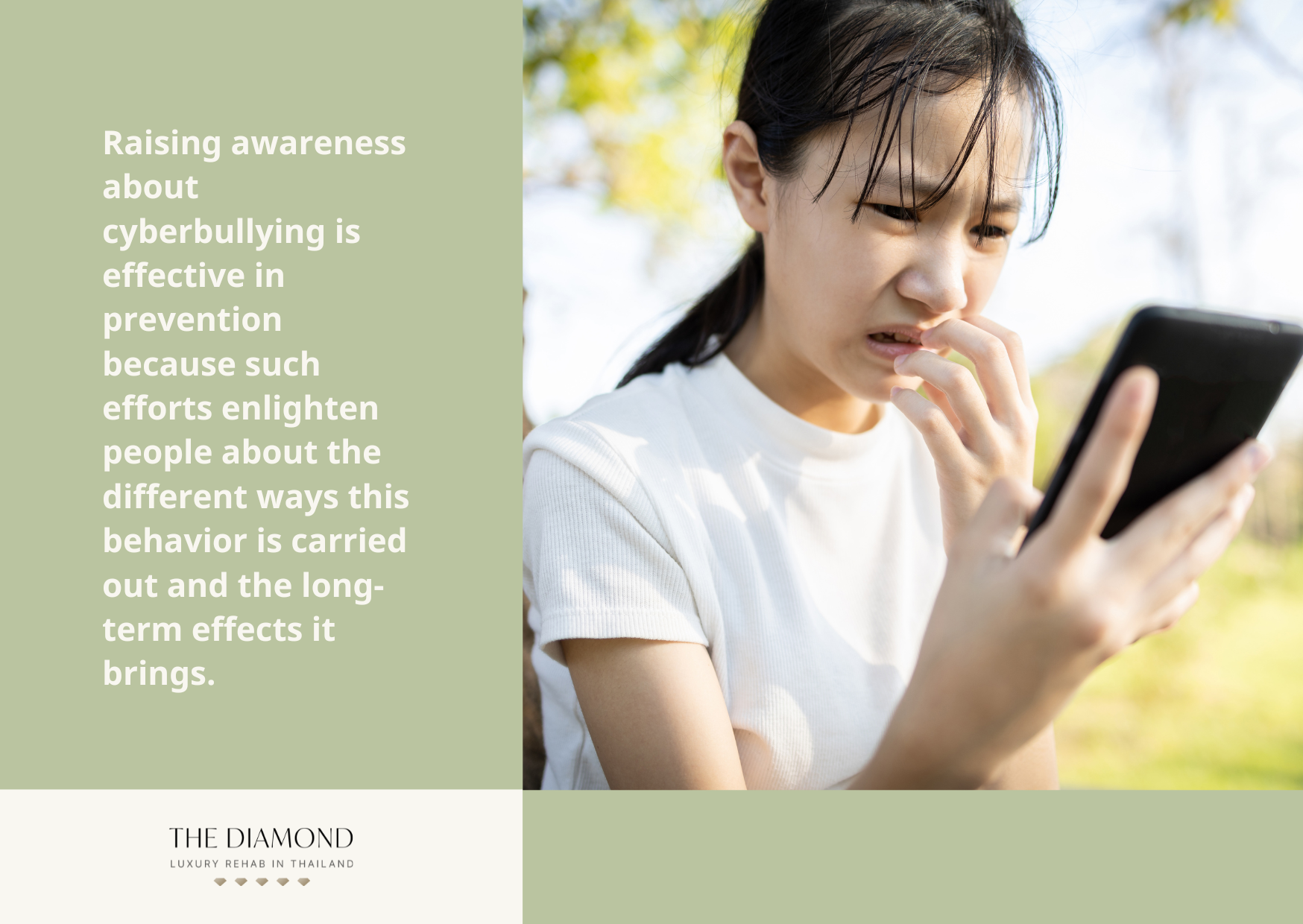
Yes, raising awareness about cyberbullying is effective in prevention because such efforts enlighten people about the different ways this behavior is carried out and the long-term effects it brings.
Public campaigns and educational initiatives shed light on the emotional distress victims face, pushing people to reconsider harmful behavior. Empowering communities to act collectively, awareness programs introduce practical steps for responding to online harassment.
In order to make the risks more accessible and difficult to overlook, organizations and educators frequently present real-life instances. Online interactions become more supportive as a result of efforts to develop empathy.
The ability of communities to recognize dangers and act swiftly improves as information circulates. A comprehensive awareness diminishes occurrences and fosters a culture of accountability. More conversations in the workplace and in schools promote continuous dialogue about the proper use of digital devices.

